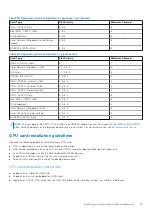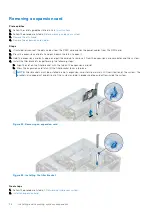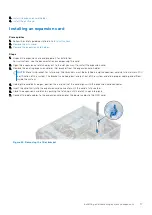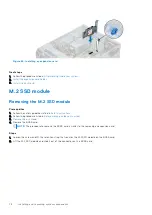
Table 14. Memory population (continued)
DIMM Type
DIMMs
Populated/
Channel
Voltage
Operating Frequency (in
MT/s)
Maximum DIMM Rank/
Channel
LRDIMM
1
1.2 V
2666, 2400, 2133, 1866
Quad rank
2
2666, 2400, 2133, 1866
Quad rank
General memory module installation guidelines
To ensure optimal performance of your system, observe the following general guidelines when configuring your system memory.
If your system's memory configurations fail to observe these guidelines, your system might not boot, stop responding during
memory configuration, or operate with reduced memory.
●
System profile selected (for example, Performance Optimized, or Custom [can be run at high speed or lower])
●
Maximum supported DIMM speed of the processors.
●
Maximum supported DIMM speed of the processors.
●
Maximum supported speed of the DIMMs
NOTE:
MT/s indicates DIMM speed in MegaTransfers per second.
The system supports Flexible Memory Configuration, enabling the system to be configured and run in any valid chipset
architectural configuration. The following are the recommended guidelines for installing memory modules:
●
All DIMMs must be DDR4.
●
RDIMMs and LRDIMMs must not be mixed.
●
64 GB LRDIMMs that are DDP (Dual Die Package) LRDIMMs must not be mixed with 128 GB LRDIMMs that are TSV
(Through Silicon Via/3DS) LRDIMMs.
●
x4 and x8 DRAM based memory modules can be mixed.
●
Up to two RDIMMs can be populated per channel regardless of rank count.
●
Up to two LRDIMMs can be populated per channel regardless of rank count.
●
A maximum of two different ranked DIMMs can be populated in a channel regardless of rank count.
●
If memory modules with different speeds are installed, they will operate at the speed of the slowest installed memory
module(s).
●
Populate memory module sockets only if a processor is installed.
○
For single-processor systems, sockets A1 to A10 are available.
○
For dual-processor systems, sockets A1 to A10 and sockets B1 to B6 are available.
●
Populate all the sockets with white release tabs first, followed by the black release tabs.
●
When mixing memory modules with different capacities, populate the sockets with memory modules with the highest
capacity first.
NOTE:
For example, if you want to mix 8 GB and 16 GB memory modules, populate 16 GB memory modules in the
sockets with white release tabs and 8 GB memory modules in the sockets with black release tabs.
●
Memory modules of different capacities can be mixed provided other memory population rules are followed.
NOTE:
For example, 8 GB and 16 GB memory modules can be mixed.
●
In a dual-processor configuration, the memory configuration for each processor must be identical.
NOTE:
For example, if you populate socket A1 for processor 1, then populate socket B1 for processor 2, and so on.
●
Mixing of more than two memory module capacities in one system is not supported.
●
Unbalanced memory configurations will result in a performance loss so always populate memory channels identically with
identical DIMMs for best performance.
●
Populate six identical memory modules per processor (one DIMM per channel) at a time to maximize performance.
DIMM population update for Performance Optimized mode with quantity of 4 and 8 DIMMs per processor.
●
When the DIMM quantity is 4 per processor, the population is slot 1, 2, 4, 5.
●
When the DIMM quantity is 8 per processor, the population is slot 1, 2, 4, 5, 7, 8, 9, 10.
Mode-specific guidelines
The configurations allowed depend on the memory mode selected in the System BIOS.
Installing and removing system components
65
















































